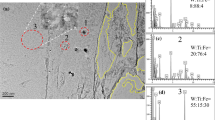Abstract
Carbide precipitation within low carbon AISI H13 hot work tool steel that had either been quenched at 80 °C or cryogenically treated at −196 °C prior to tempering has been examined using micrometer-scale synchrotron diffraction mapping. Vanadium-rich cubic M8C7 carbide, lattice parameter of approximately 0.8610 nm, not identifiable using laboratory powder x-ray diffraction (PXRD), was found to be present in all samples. The concentration of this phase was greatest in the rapidly cooled cryogenically treated sample. However, all cryogenic treatments resulted in greater carbide concentrations than in the quenched sample. In addition rapid cryogenic cooling by immersion in liquid nitrogen (N2), as compared with slow cooling to −196 °C over a 3 h duration, results in greater order within the carbide phase subsequent to tempering, as interpreted by analysis of unit cell size variation, and the smallest stress, as interpreted by diffraction peak full width half maximum height distributions.













Similar content being viewed by others
References
D.N. Collins: Deep cryogenic treatment of tool steels: A review. Heat Treat. Met. 2, 40–42 (1996).
R.F. Barron: Cryogenic treatment of metals to improve wear resistance. Cryogenics 22, 409–413 (1982).
N.R. Dhar, S. Paul, and A.B. Chattopadhyay: The influence of cryogenic cooling on tool wear, dimensional accuracy and surface finish in turning AISI 1040 and E4340C steels. Wear 249, 932–942 (2001).
D. Mohan Lal, S. Renganarayanan, and A. Kalanidhi: Cryogenic treatment to augment wear resistance of tool and die steels. Cryogenics 41, 149–155 (2001).
K. Moore and D.N. Collins: Cryogenic treatment of three heat-treated tool steels. Key Eng. Mater. 86–, 47–54 (1993).
Y.M. Rhyim, S.H. Han, Y.S. Na, and J.H. Lee: Effect of deep cryogenic treatment on carbide precipitation and mechanical properties of tool steel. Solid State Phenomena 118, 9–14 (2006).
J.Y. Huang, Y.T. Zhu, X.Z. Liao, I.J. Beyerlein, M.A. Bourke, and T.E. Mitchell: Microstructure of cryogenic treated M2 tool steel. Mater. Sci. Eng., A 339, 241–244 (2003).
M. Pellizzari, A. Molinari, S. Gialanella, and G. Straffelini: Effect of deep cryogenic treatment on the microstructural properties of AISI H13 steel. Metallurgia Italiana 93, 21 (2001).
V. Firouzdor, E. Nejati, and F. Khomamizadeh: Effect of deep cryogenic treatment on wear resistance and tool life of M2 HSS drill. J. Mater. Process. Technol. 206, 467–472 (2008).
A. Akhbarizadeh, A. Shafyei, and M.A. Golozar: Effects of cryogenic treatment on wear behavior of D6 tool steel. Mater. Des. 30, 3259–3264 (2009).
A. Bensely, A. Prabhakaran, D. Mohan Lal, and G. Nagarajan: Enhancing the wear resistance of case carburized steel (En 353) by cryogenic treatment. Cryogenics 45, 747–754 (2005).
D. Das, A.K. Dutta, and K.K. Ray: Influence of varied cryotreatment on the wear behavior of AISI D2 steel. Wear 266, 297–309 (2009).
P. Stratton and M. Graf: The effect of deep cold induced nanocarbides on the wear of case hardened components, Cryogenics 49, 346–349 (2009).
G. Krauss: Steels: Heat Treatment and Processing Principles.(ASM International, Materials Park, OH, 1995).
G.A. Roberts and R.A. Cary: Tool Steels, American Society for Metals (Beachwood, OH, 1980).
D.T. Llewellyn: Steels: Metallurgy and Applications (Butterworth Heinemann, Boston, MA, 1992).
N. Xu, G.P. Cavallaro, and A.R. Gerson: Synchrotron microdiffraction analysis of the microstructure of cryogenically treated high performance tool steels prior to and after tempering. Mater. Sci. Eng., A 527, 6822–6830 (2010).
X.B. Hu, M. Zhang, X.C. Wu, and L. Li: Simulations of coarsening behavior for M23C6 carbides in AISI H13 steel. J. Mater. Sci. Technol. 22, 153–158 (2006).
V.N. Lipatnikov, A.I. Gusev, P. Ettmayer, and W. Lengauer: Phase transformation in nonstoichiometric vanadium carbide. J. Phys. Condens. Matter 11, 163–184 (1999).
T. Tsakalakos, L.A. Ovid’ko, and A.K. Vasudevan: Nanostructures: Synthesis, Functional Properties and Applications (Kluwer Academic Publishers, Dordrecht, Netherlands, 2003).
R.E. Dinnebier and S.J.L Billinge: Powder Diffraction: Theory and Practice (Royal Society of Chemistry, London, UK, 2008).
T. Ungár: Strain broadening caused by dislocations. Mater. Sci. Forum 278–, 151–157 (1998).
T. Rzychoñ and K. Rodak: Microstructure characterization of deformed copper by XRD line broadening. Arch. Mater. Sci. Eng. 28, 605–608 (2007).
J.I. Langford and A.J.C Wilson: Scherrer after sixty years: A survey and some new results in the determination of crystallite size. J. Appl. Crystallogr. 11, 102–113 (1978).
Acknowledgments
The authors gratefully acknowledge Dr. Wenjun Liu, XOR/UNI-CAT, APS and Steve Heald, PNC-CAT, APS for their advice. The use of the APS was supported by the U.S. Department of Energy, Office of Science, Office of Basic Energy Sciences, under Contract No. DE-AC02-06CH11357. We acknowledge travel funding provided by the Australian Synchrotron Research Program. The authors appreciate the financial support provided by the University of South Australia in the form of a University President Scholarship (UPS) and the Applied Centre for Structural and Synchrotron Studies in a form of an ACeSSS scholarship. Also the authors express their gratitude to Tijun Lu, Applied Centre for Structure and Synchrotron Studies, University of South Australia for the help with implementation of IDL software. The participation of ARG in this research was supported under the Australian Research Council’s Linkage Project funding scheme (Project No. LP0562210) which was sponsored by Rio Tinto and the Department of Innovation, Industry and Regional Development, State Government of Victoria.
Author information
Authors and Affiliations
Corresponding author
Rights and permissions
About this article
Cite this article
Xu, N., Cavallaro, G.P. & Gerson, A.R. Micrometer-scale synchrotron diffraction mapping analysis of carbide precipitation in deep cryogenically treated low carbon steel. Journal of Materials Research 27, 2122–2130 (2012). https://doi.org/10.1557/jmr.2012.135
Received:
Accepted:
Published:
Issue Date:
DOI: https://doi.org/10.1557/jmr.2012.135




